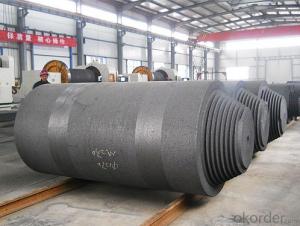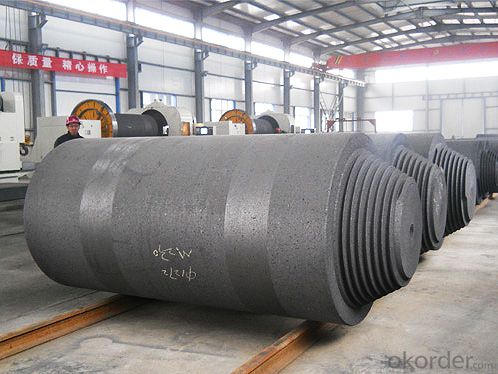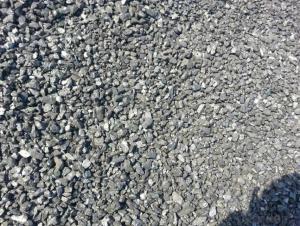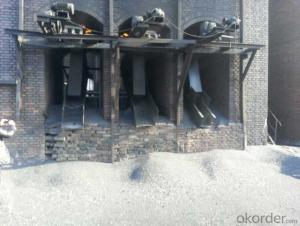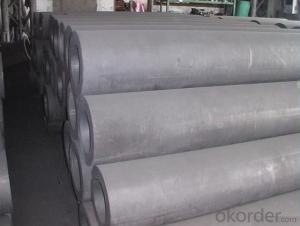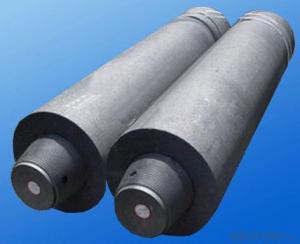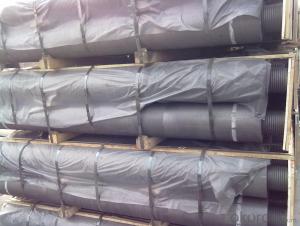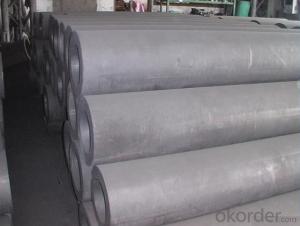Carbon Electrode With Φ500~Φ700 G Grade And Stable Quality
- Loading Port:
- Tianjin
- Payment Terms:
- TT or LC
- Min Order Qty:
- 20 m.t.
- Supply Capability:
- 800 m.t./month
OKorder Service Pledge
OKorder Financial Service
You Might Also Like
General Specification
PARAMETER UNIT GUARANTEE VALUE | ||||||
Ash.( % ) | 4.0 max | 5.0 max | 6.0 max | 7.0 max | 9.0 max | 11.0 max |
V.M (%) | 12.0-15.5 | 12.0-15.5 | 12.0-15.5 | 9.5-13.5 | 11.5-15.5 | 11.5-15.5 |
Compress Strength. (Mpa) | 18.0 min | 17 min | 15.7 min | 19.6 min | 19.6 min | 19.6 min |
Specific Resistance (μΩm) | 65 max | 68 max | 75 max | 80 max | 90 max | 90 max |
Bulk Density (G/CM3) | 1.38 min | 1.38 min | 1.38 min | 1.38 min | 1.38 min | 1.38 min |
Product Description
Carbon Electrode is abaked electrode used in submerged arc furnaces for delivering power to the charge mix. Electrode is added to the top of the electrode column cylindrical form. Electrode is essentially a mix of Electrically Calcined Anthracite (ECA) or Calcined Petroleum Coke (CPC) with Coal Tar Pitch and is baked for weeks, it is widly used for for ferroalloy,calcium carbide, silicon metal, production etc.
Picture
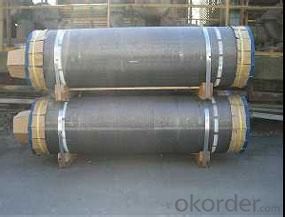
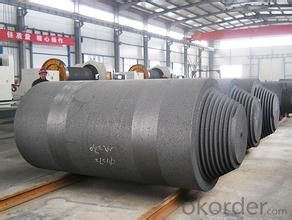
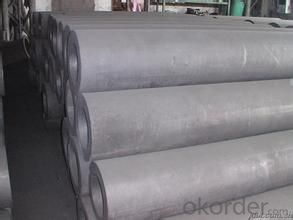
We Also supply all kind of carbon electrode paste and below materials, please contact us if you have any enquiry about it.
Calcined Anthracite
Calcined Petroleum Coke
Coke (Met Coke, Foundry Coke, Semi Coke)
- Q: What are carbon offsets?
- The use of carbon offsets is a method employed to aid in the reduction of greenhouse gas emissions and the fight against climate change. Essentially, it offers a means for individuals, organizations, or businesses to compensate for their own carbon dioxide (CO2) emissions by investing in projects that decrease emissions in other places. Carbon offsets are founded on the concept that emissions reduction can be accomplished through various methods and at different costs. Rather than solely focusing on reducing their own emissions, individuals or entities can utilize carbon offsetting to support projects that can achieve greater emission reductions per unit of cost. These projects encompass renewable energy, energy efficiency, reforestation, methane capture, and others. To obtain carbon offsets, individuals or organizations typically calculate their own carbon footprint by evaluating the amount of CO2 they emit through activities like energy consumption or transportation. After quantifying their emissions, they can purchase carbon offsets equivalent to the amount of CO2 they have emitted. These offsets are generated by projects that undergo independent verification and certification by recognized standards and registries. Once purchased, the carbon offsets are effectively canceled or retired, ensuring that the emission reduction accomplished by the project is not double-counted or claimed by another party. By investing in carbon offsets, individuals or organizations can effectively neutralize their own emissions and contribute to global endeavors to combat climate change. However, it is crucial to recognize that carbon offsets should not be viewed as a substitute for reducing emissions at the source. They should be utilized as a supplementary tool to support emission reduction efforts while simultaneously implementing measures to minimize our own emissions through energy efficiency, adoption of renewable energy, and sustainable practices.
- Q: Can carbon be recycled?
- Yes, carbon can be recycled.
- Q: What are the consequences of increased carbon emissions on educational systems?
- Increased carbon emissions have profound consequences on educational systems. One of the major consequences is the negative impact on the health and well-being of students and teachers. Carbon emissions contribute to air pollution, which can lead to respiratory problems, allergies, and other health issues. This, in turn, affects attendance rates and overall student performance. Furthermore, the effects of climate change caused by carbon emissions, such as extreme weather events and rising temperatures, can disrupt educational infrastructure. Schools may be closed or damaged due to hurricanes, floods, or heatwaves, leading to a loss of instructional time and disruption to the learning environment. In addition, increased carbon emissions contribute to the depletion of natural resources, such as water and food, which can have severe consequences for educational systems. In regions heavily reliant on agriculture, climate change can disrupt food production and availability, leading to malnutrition and reduced cognitive development in children. Lack of access to clean water can also impact sanitation in schools, increasing the risk of diseases and impacting students' ability to concentrate and learn. Moreover, the consequences of increased carbon emissions extend beyond physical health and infrastructure. Climate change is a complex global issue that requires an understanding of scientific concepts and critical thinking skills to address. However, inadequate education on climate change and its causes can hinder students' ability to comprehend and respond to this pressing issue. Furthermore, the economic impacts of climate change resulting from increased carbon emissions can strain educational systems. Governments may have to divert resources away from education to address climate-related disasters and their aftermath. Limited funding for education can lead to reduced access to quality education, inadequate facilities, and lower teacher salaries, all of which can negatively impact the overall quality of education provided. In conclusion, increased carbon emissions have wide-ranging consequences on educational systems. From the health and well-being of students and teachers to disruptions in infrastructure and access to resources, the effects of carbon emissions can hinder educational outcomes. Addressing climate change and reducing carbon emissions is crucial not just for the environment but also for the future of education.
- Q: What is carbon offsetting in the food industry?
- Carbon offsetting in the food industry refers to the practice of reducing or compensating for the greenhouse gas emissions produced throughout the food supply chain, from production to consumption. This is typically done by investing in projects that reduce emissions elsewhere, such as renewable energy projects or reforestation initiatives, to balance out the carbon footprint associated with food production and consumption.
- Q: What are the environmental impacts of carbon emissions from industries?
- The environmental consequences resulting from industries' carbon emissions are significant and extensive. To begin with, carbon emissions contribute to the greenhouse effect, resulting in global warming and climate change. The excessive release of carbon dioxide and other greenhouse gases into the atmosphere traps heat, leading to a rise in the Earth's temperature. Consequently, polar ice caps melt, sea levels increase, and extreme weather events like hurricanes and droughts occur. These alterations disrupt ecosystems, cause biodiversity loss, and jeopardize the survival of various species. Furthermore, carbon emissions contribute to air pollution. Industries release not only carbon dioxide but also harmful pollutants like sulfur dioxide, nitrogen oxides, and particulate matter. These pollutants have adverse effects on human health, causing respiratory and cardiovascular problems, and even premature death. Additionally, they contribute to the creation of smog and acid rain, causing further harm to ecosystems and endangering plant and animal life. Moreover, carbon emissions from industries negatively impact water systems. When carbon dioxide dissolves in water, it forms carbonic acid, resulting in a decrease in pH levels and increased acidity. This acidification harms marine life, especially organisms with calcium carbonate shells or skeletons, such as coral reefs, shellfish, and plankton. The disruption of marine ecosystems can have a ripple effect on other species and disturb the food chain. Lastly, carbon emissions contribute to deforestation and habitat destruction. Industries often rely on fossil fuels for energy, leading to the clearing of forests to make way for mining or drilling operations. This destruction of natural habitats not only reduces biodiversity but also releases stored carbon from trees into the atmosphere, exacerbating the carbon emissions problem. To address these environmental impacts, industries must prioritize the reduction of carbon emissions. This can be achieved by adopting cleaner and more sustainable energy sources, implementing energy-efficient technologies, and enforcing stricter regulations and policies. Transitioning to renewable energy, improving industrial processes, and investing in carbon capture and storage technologies are vital steps toward mitigating the environmental consequences of industries' carbon emissions.
- Q: How does carbon dioxide contribute to global warming?
- The primary cause of global warming is the contribution of carbon dioxide (CO2) through the greenhouse effect. This phenomenon arises when specific gases in the Earth's atmosphere trap solar heat, preventing its escape into space. Although the greenhouse effect is a natural process that aids in preserving the Earth's temperature, human activities, particularly the combustion of fossil fuels, have significantly raised the concentration of CO2 in the atmosphere. When fossil fuels such as coal, oil, and natural gas are burned for energy generation, they release CO2 as a byproduct. This surplus of CO2 functions as a gas that traps heat, absorbing and subsequently emitting heat radiation that would otherwise dissipate into space. Consequently, the Earth's temperature is increasing, resulting in global warming. The repercussions of elevated global temperatures are extensive. They expedite the melting of polar ice caps and glaciers, leading to rising sea levels that jeopardize coastal regions and low-lying islands. Additionally, they disrupt weather patterns, resulting in more frequent and severe occurrences of heatwaves, droughts, hurricanes, and floods. Furthermore, global warming adversely affects ecosystems by causing shifts in habitats, loss of biodiversity, and detrimental impacts on plant and animal species. Reducing carbon dioxide emissions is of utmost importance in mitigating global warming. This objective can be accomplished through diverse approaches, such as transitioning to renewable energy sources, enhancing energy efficiency, investing in sustainable transportation, and implementing practices that foster reforestation and carbon sequestration. By undertaking these measures, we can decelerate the pace of global warming and alleviate its detrimental effects on both the planet and its inhabitants.
- Q: What is the most common isotope of carbon?
- The most common isotope of carbon is carbon-12. It is called carbon-12 because it has an atomic mass of 12 atomic mass units, which is determined by the number of protons and neutrons in its nucleus. Carbon-12 is abundant in nature, making up approximately 98.9% of all carbon atoms. The other two isotopes of carbon, carbon-13 and carbon-14, are less common and exist in much smaller proportions. Carbon-12 is stable and does not undergo radioactive decay, which makes it an essential element for life on Earth.
- Q: How does carbon dioxide affect the health of marine organisms?
- The health of marine organisms can be significantly impacted by carbon dioxide. Seawater absorbs carbon dioxide, causing a chemical reaction that results in increased acidity, known as ocean acidification. Ocean acidification hampers the ability of numerous marine organisms to construct and maintain their shells and skeletons. Organisms like corals, oysters, and shellfish rely on calcium carbonate to form their protective structures. However, in more acidic conditions, the availability of carbonate ions decreases, making it more difficult for these organisms to calcify. This can result in weakened shells, reduced growth rates, and heightened susceptibility to predation and disease. Moreover, ocean acidification can disturb the reproductive and developmental processes of marine organisms. Higher levels of CO2 have been shown in some studies to affect fish's ability to locate preferred habitats, find mates, and successfully reproduce. Additionally, certain species of fish and invertebrates demonstrate altered behavior and impaired sensory functions under high CO2 conditions. In addition to the direct effects, ocean acidification can also indirectly impact marine organisms by disrupting entire ecosystems. For example, the decline of coral reefs due to reduced calcification can have far-reaching effects on the entire reef ecosystem, affecting the biodiversity and productivity of these crucial marine habitats. In summary, the rising levels of atmospheric carbon dioxide not only contribute to global climate change but also lead to ocean acidification, posing significant threats to the health and survival of many marine organisms. It is imperative to address and mitigate the causes of carbon dioxide emissions to safeguard the delicate balance of our oceans and the diverse range of species that rely on them for survival.
- Q: How dnf advanced carbon ashes?
- That thing is called the advanced furnace rock carbon... Not ash carbon...... It was bought at the mall (sold before, no now), with a success rate plus ten percent.
- Q: How does carbon dioxide affect the formation of clouds?
- Carbon dioxide plays a significant role in the formation of clouds through its impact on Earth's climate system. As a greenhouse gas, carbon dioxide traps heat in the atmosphere, leading to an overall increase in global temperatures. This rise in temperature alters various atmospheric processes, including cloud formation. One of the key ways carbon dioxide affects cloud formation is by influencing the water cycle. Warmer temperatures caused by increased carbon dioxide levels lead to enhanced evaporation of water from the Earth's surface. This increased evaporation results in a higher amount of water vapor in the atmosphere, which serves as the primary ingredient for cloud formation. Additionally, carbon dioxide affects cloud formation indirectly by influencing atmospheric stability and the vertical movement of air. Higher concentrations of carbon dioxide can alter the temperature profile of the atmosphere, with the lower atmosphere warming more than the upper atmosphere. This temperature difference can lead to changes in air density, causing air to rise or sink. Rising air creates conditions favorable for cloud formation, while sinking air inhibits it. Furthermore, carbon dioxide affects the size and properties of cloud droplets. Increased carbon dioxide concentrations can lead to changes in the microphysical properties of clouds, such as droplet size and concentration. Studies suggest that higher concentrations of carbon dioxide can result in smaller cloud droplets, potentially affecting cloud lifetime and precipitation patterns. It is important to note that the relationship between carbon dioxide and cloud formation is complex and still an active area of research. Scientists continue to study the intricate interactions between atmospheric gases, cloud formation, and climate change to better understand the future implications of carbon dioxide emissions on cloud dynamics and the overall climate system.
Send your message to us
Carbon Electrode With Φ500~Φ700 G Grade And Stable Quality
- Loading Port:
- Tianjin
- Payment Terms:
- TT or LC
- Min Order Qty:
- 20 m.t.
- Supply Capability:
- 800 m.t./month
OKorder Service Pledge
OKorder Financial Service
Similar products
Hot products
Hot Searches
